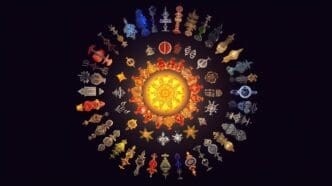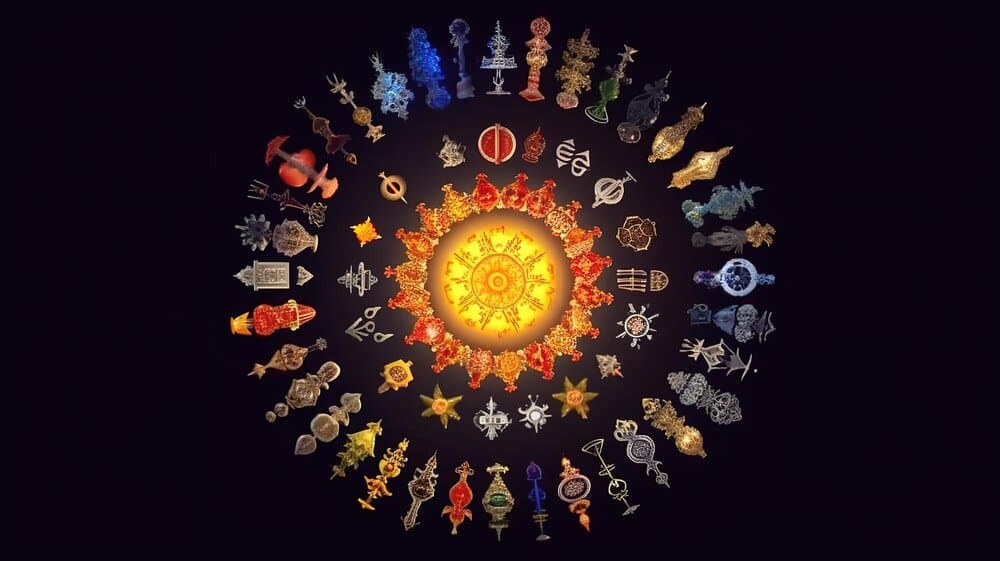Reading a Vedic astrology chart, known as a Kundli or Janma Patrika, is the sacred art of interpreting a cosmic blueprint of the heavens, cast for the exact moment of an individual’s birth. For anyone seeking profound self-understanding, this chart reveals the karmic patterns, innate personality, and potential life trajectory encoded by the planets. The entire process hinges on analyzing the interplay between planets (Grahas), zodiac signs (Rashis), and the twelve houses (Bhavas) which represent all areas of life. While the information is universal, it is presented in two distinct visual formats—the square South Indian chart and the diamond-shaped North Indian chart—both serving as a map to navigate one’s strengths, challenges, relationships, and ultimate purpose.
The Foundations of a Vedic Chart
At its core, a Vedic birth chart is a celestial snapshot. It freezes the positions of the nine planets, as seen from the specific time and place of your birth, against the backdrop of the twelve zodiac signs. This map is then divided into twelve segments called houses, or Bhavas.
The interpretation of this chart rests on three fundamental pillars. The first is the Grahas, or the planets, which are the active forces, the agents of karma. The second is the Rashis, or zodiac signs, which act as filters, coloring how a planet’s energy is expressed. The third is the Bhavas, or houses, which represent the specific domains of life where this energy manifests, such as career, marriage, or health.
Decoding the Chart Styles: North vs. South Indian
Before any analysis can begin, one must understand how to read the chart’s layout. While both the South and North Indian styles contain the exact same astrological data, their visual presentation and method of reading differ significantly. The choice between them is purely a matter of regional tradition and personal preference.
The South Indian Chart (Square Style)
The South Indian chart is a simple grid of 12 squares. Its defining feature is that the zodiac signs are fixed. The second box from the top left is always Aries (Mesha), followed by Taurus (Vrishabha), Gemini (Mithuna), and Cancer (Kataka) moving clockwise along the outer squares. The signs always proceed in this clockwise direction.
To read this chart, the first step is to locate the Ascendant, which is marked with “As,” “Asc,” or “Lagna.” This box becomes the 1st House. From there, you count the houses sequentially in a clockwise direction. For example, if the Ascendant is marked in the box for Leo (Simha), then Leo is the 1st House, Virgo (Kanya) is the 2nd House, Libra (Tula) is the 3rd, and so on. The planets are then noted within the squares of the signs they occupy.
Many astrologers favor this style because the fixed nature of the signs makes it easy to visualize planetary aspects and transits. The relationship between signs is always visually consistent, regardless of the Ascendant.
The North Indian Chart (Diamond Style)
The North Indian chart, often called the diamond or kite chart, operates on a different principle: the houses are fixed, while the signs move. The top diamond in the chart is always the 1st House (the Ascendant). The houses are then counted in a counter-clockwise direction. The second house is the diamond to the left, the third is below that, and the fourth is the large central square at the bottom.
In this style, small numbers from 1 to 12 are written in each house to denote the zodiac sign occupying it (1 for Aries, 2 for Taurus, 3 for Gemini, etc.). For instance, if the number “5” is in the top diamond (the 1st House), it means the native has a Leo Ascendant. The planets are then placed in the houses according to their sign placements.
This chart’s strength lies in its clear depiction of the houses. The four central diamonds are the angular houses (Kendras: 1, 4, 7, 10), which are pillars of the horoscope. This layout makes it immediately obvious which planets occupy these powerful positions.
The Building Blocks: Planets, Signs, and Houses
Understanding the individual components is the key to synthesizing the message of the chart. Each element contributes a unique layer of meaning to the overall interpretation.
The Nine Grahas (Planets)
Vedic astrology uses nine primary celestial bodies, or Grahas. These are not just physical objects but energetic influences that deliver karma.
- Sun (Surya): Represents the soul, ego, father, authority, and vitality.
- Moon (Chandra): Signifies the mind, emotions, mother, public life, and receptivity.
- Mars (Mangal): Governs energy, action, courage, siblings, conflict, and ambition.
- Mercury (Budha): Rules intellect, communication, logic, learning, and commerce.
- Jupiter (Guru): Represents wisdom, expansion, fortune, spirituality, children, and teachers.
- Venus (Shukra): Signifies love, beauty, luxury, relationships, art, and pleasure.
- Saturn (Shani): Governs discipline, responsibility, limitation, karma, longevity, and sorrows.
- Rahu (North Node): A shadow planet representing worldly desire, obsession, foreign influences, and future karma.
- Ketu (South Node): A shadow planet representing detachment, spirituality, past life skills, and liberation.
The Twelve Rashis (Zodiac Signs)
The zodiac signs are the cosmic fields through which the planets operate. Each sign imparts its own distinct quality to any planet residing within it.
- Aries (Mesha): Fiery, pioneering, impulsive.
- Taurus (Vrishabha): Earthy, stable, sensual.
- Gemini (Mithuna): Airy, communicative, curious.
- Cancer (Kataka): Watery, emotional, nurturing.
- Leo (Simha): Fiery, regal, confident.
- Virgo (Kanya): Earthy, analytical, service-oriented.
- Libra (Tula): Airy, balanced, diplomatic.
- Scorpio (Vrishchika): Watery, intense, transformative.
- Sagittarius (Dhanu): Fiery, philosophical, optimistic.
- Capricorn (Makara): Earthy, disciplined, ambitious.
- Aquarius (Kumbha): Airy, humanitarian, unconventional.
- Pisces (Meena): Watery, intuitive, compassionate.
The Twelve Bhavas (Houses)
The houses pinpoint where the planetary energies will manifest in your life. Each Bhava governs specific life domains.
- 1st House: Self, personality, physical body, appearance, and overall life path.
- 2nd House: Accumulated wealth, family lineage, food, and speech.
- 3rd House: Courage, siblings, short journeys, communication, and self-effort.
- 4th House: Mother, home, property, vehicles, and emotional happiness.
- 5th House: Children, creativity, intellect, education, investments, and romance.
- 6th House: Health, debts, enemies, daily work, and service.
- 7th House: Marriage, spouse, business partnerships, and public image.
- 8th House: Longevity, transformation, death, inheritance, and hidden knowledge.
- 9th House: Father, fortune, higher education, religion, and long journeys.
- 10th House: Career, profession, reputation, status, and public action (Karma).
- 11th House: Gains, income, friendships, aspirations, and elder siblings.
- 12th House: Expenses, loss, spirituality, liberation (Moksha), and foreign lands.
The Art of Synthesis: Putting It All Together
Reading a chart is more than just listing ingredients; it’s about understanding the recipe. The synthesis begins by identifying the most influential points in the horoscope.
Step 1: Identify the Ascendant (Lagna)
The Ascendant is the zodiac sign that was rising on the eastern horizon at the moment of birth. It is the 1st House and the single most important point in the chart. It defines your core identity, physical constitution, and the lens through which you view the world. The entire structure of your life’s experiences is built upon this foundation.
Step 2: Analyze the Ascendant Lord
The planet that rules the Ascendant sign is the “lord of the chart.” Its placement and condition are of paramount importance. For example, if you have a Gemini Ascendant, your chart lord is Mercury. If that Mercury is placed in the 10th House of career, your life path will be intrinsically linked to communication, intellect, and professional achievement.
Step 3: Examine the Planets in the Houses
The basic formula for interpretation is: **Planet + Sign + House = Result.** A planet’s natural qualities are modified by the sign it’s in, and this combined energy plays out in the area of life indicated by the house. For example, a disciplined Saturn (planet) placed in the intellectual sign of Virgo (sign) in the 5th House (creativity, education) could indicate a meticulous student, a technical writer, or a detail-oriented artist.
Step 4: Consider Planetary Strength and Dignity
Not all planets are created equal in a chart. A planet can be powerful or weak depending on its sign placement. A planet in its own sign (Swakshetra) or its sign of exaltation (Ucha) is strong and gives positive results. Conversely, a planet in its sign of debilitation (Neecha) is weakened and can present challenges.
Step 5: Look at Aspects (Drishti)
Planets do not act in isolation; they cast “aspects,” or glances, to other houses and planets, creating a web of influence. All planets aspect the 7th house directly opposite them. However, the outer planets have special aspects: Mars aspects the 4th and 8th houses from its position; Jupiter aspects the 5th and 9th; and Saturn aspects the 3rd and 10th. These aspects add critical layers of complexity and connection throughout the chart.
Beyond the Basics: Yogas and Dashas
Once you master the fundamentals, you can explore the more advanced predictive techniques of Vedic astrology.
Yogas: Planetary Combinations
Yogas are specific combinations of planets that produce powerful and well-defined results. There are hundreds of yogas, ranging from those that promise immense wealth and power (Dhana and Raja Yogas) to those that indicate challenges. Identifying key yogas is crucial for understanding the major themes and potentials of a person’s life.
The Dasha System: The Element of Time
Perhaps the most unique feature of Vedic astrology is its Dasha system, a sophisticated method for timing life events. It tells you *when* the promises held within the birth chart are likely to unfold. The most widely used system, Vimshottari Dasha, maps out a 120-year cycle of planetary periods, assigning a “major period” (Mahadasha) to each planet. During a planet’s Dasha, its qualities and the results of the houses it influences will become prominent in your life.
Learning to read a Vedic chart is a journey into the language of the cosmos and the self. It begins with understanding the core components—planets, signs, and houses—within the structure of a North or South Indian chart. By systematically layering these elements, one can decode the karmic map that guides our existence. It is an unparalleled tool for self-awareness, offering clarity on our life’s purpose and empowering us to navigate our path with greater wisdom and confidence.








